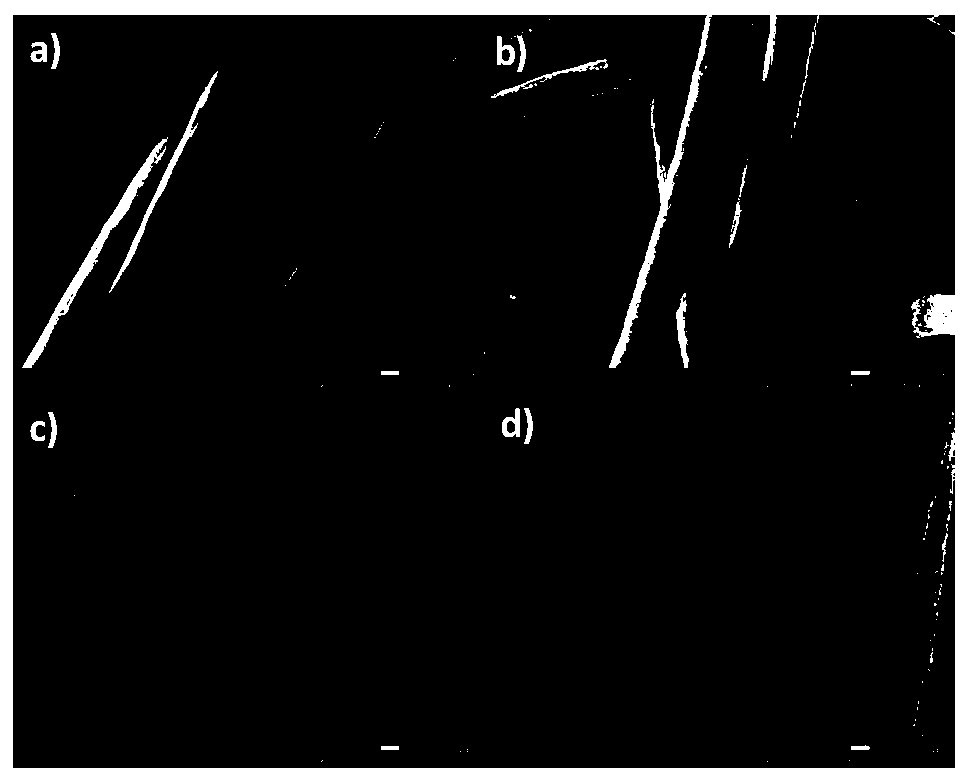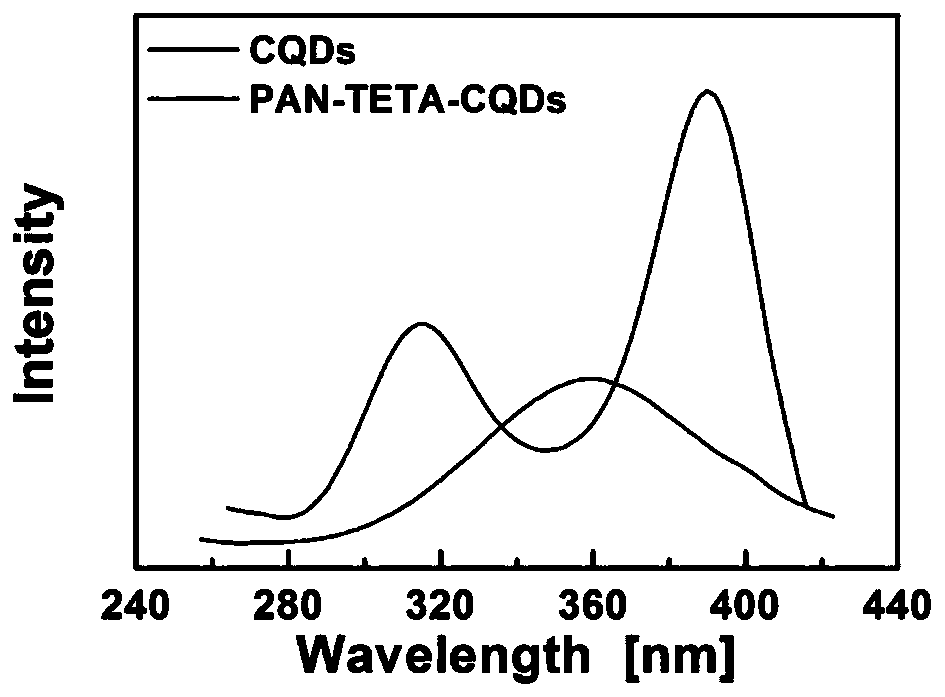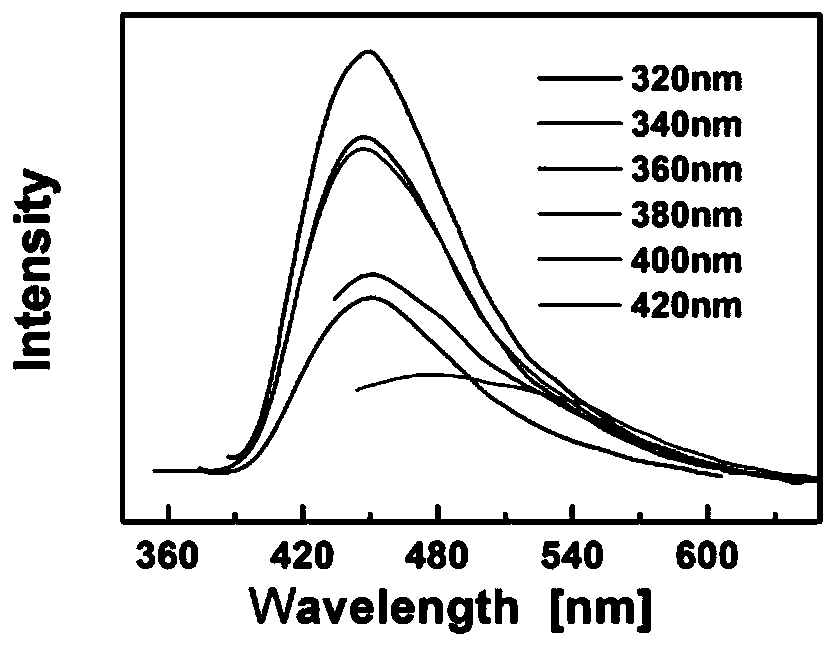A kind of fiber immobilization method of fluorescent carbon nanomaterials
A carbon nanomaterial and fluorescence technology, applied in the directions of luminescent materials, fiber processing, chemical instruments and methods, etc., can solve the problems of separation and recycling, and achieve the effect of maintaining the shape, easy to handle, and convenient to operate.
- Summary
- Abstract
- Description
- Claims
- Application Information
AI Technical Summary
Problems solved by technology
Method used
Image
Examples
Embodiment 1
[0040] The fiber immobilization method of fluorescent carbon nanomaterial of the present invention, the detailed steps of this immobilization method are as follows:
[0041] a, first 5g weakly basic ion-exchange fiber (this weakly basic ion-exchange fiber is the adsorption fiber prepared according to Example 1 in the invention patent description of CN95116025.7 according to the patent number) is added in 100ml water and swells, and the swelling time is 1h, after swelling, the solvent was filtered out to obtain the swollen weakly basic ion exchange fiber;
[0042] b. Ultrasonically disperse 0.05g of carbon quantum dots in 50mL of water, then add the swollen weakly basic ion-exchange fiber in step a and stir evenly;
[0043] c. Heat the oil bath of the mixed materials stirred uniformly in step b to 40° C., react at this temperature for 48 hours, and cool to room temperature after the reaction;
[0044] d. Wash the cooled product in step c with water and ethanol in sequence, and...
Embodiment 2
[0046] The fiber immobilization method of fluorescent carbon nanomaterial of the present invention, the detailed steps of this immobilization method are as follows:
[0047] a, first 0.1g weakly acidic ion exchange fiber (this weakly acidic ion exchange fiber is the hydrogen type ion exchange fiber prepared according to Example 3 in the invention patent description of CN200410060275.0) is added in 20ml dichloroethane Carry out swelling, the swelling time is 48h, after swelling, the solvent is filtered out to obtain the swollen weakly acidic ion exchange fiber;
[0048]b. ultrasonically disperse 0.1g of graphene oxide quantum dots in a mixed solution of 10mL of water and ethanol, then add the swollen weakly acidic ion-exchange fibers in step a and stir evenly;
[0049] c. Transfer the uniformly stirred mixed material in step b into a 50ml hydrothermal reactor, heat up to 180°C, react at this temperature for 1 hour, and cool to room temperature after the reaction;
[0050] d. T...
Embodiment 3
[0052] The fiber immobilization method of fluorescent carbon nanomaterial of the present invention, the detailed steps of this immobilization method are as follows:
[0053] a, first add 1g of weakly acidic ion exchange fiber (this weakly acidic ion exchange fiber is the hydrogen ion exchange fiber prepared according to Example 1 in the patent specification for invention of CN200410060275.0) into 50ml of nitrobenzene for swelling , the swelling time is 24h, and the solvent is filtered out after swelling to obtain the swollen weakly acidic ion exchange fiber;
[0054] b. Ultrasonic dispersion of 0.2g graphene quantum dots in a mixed solution of 30mL N,N-dimethylformamide and dimethyl sulfoxide, then adding the swollen weakly acidic ion-exchange fibers in step a and stirring evenly;
[0055] c. Put the uniformly stirred mixed material in step b into a microwave reactor, heat up to 140° C., react at this temperature for 2 hours, and cool to room temperature after the reaction;
...
PUM
| Property | Measurement | Unit |
|---|---|---|
| diameter | aaaaa | aaaaa |
Abstract
Description
Claims
Application Information
 Login to View More
Login to View More - R&D
- Intellectual Property
- Life Sciences
- Materials
- Tech Scout
- Unparalleled Data Quality
- Higher Quality Content
- 60% Fewer Hallucinations
Browse by: Latest US Patents, China's latest patents, Technical Efficacy Thesaurus, Application Domain, Technology Topic, Popular Technical Reports.
© 2025 PatSnap. All rights reserved.Legal|Privacy policy|Modern Slavery Act Transparency Statement|Sitemap|About US| Contact US: help@patsnap.com



